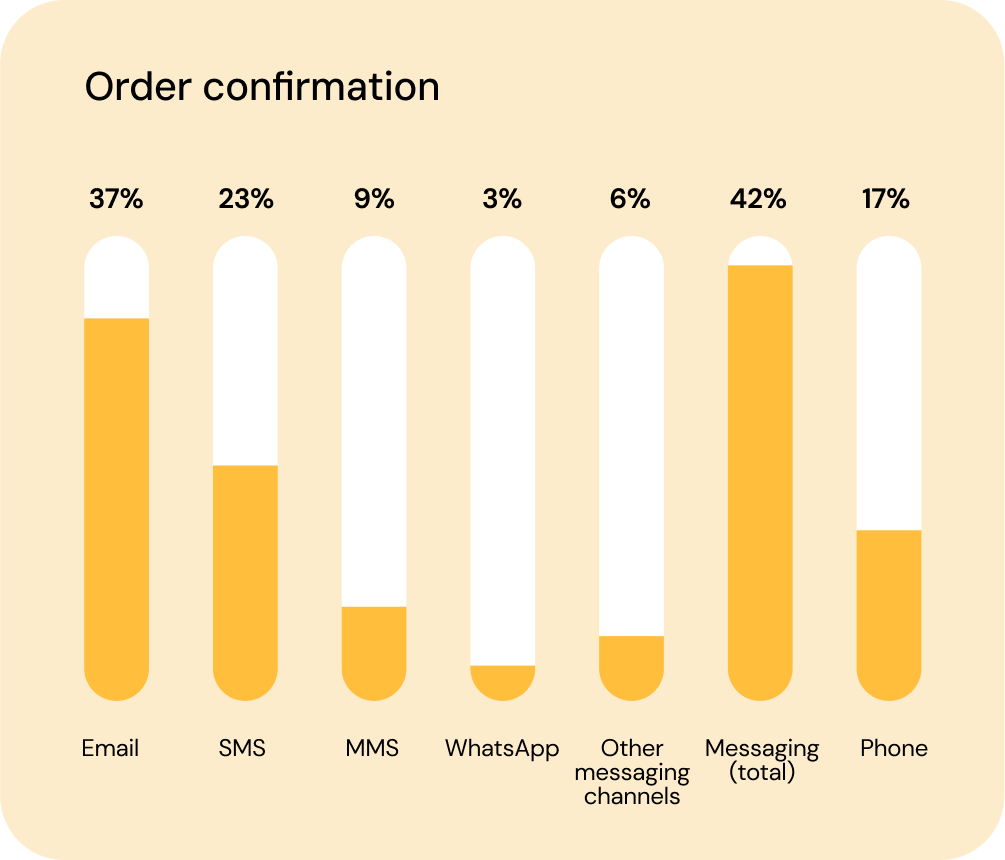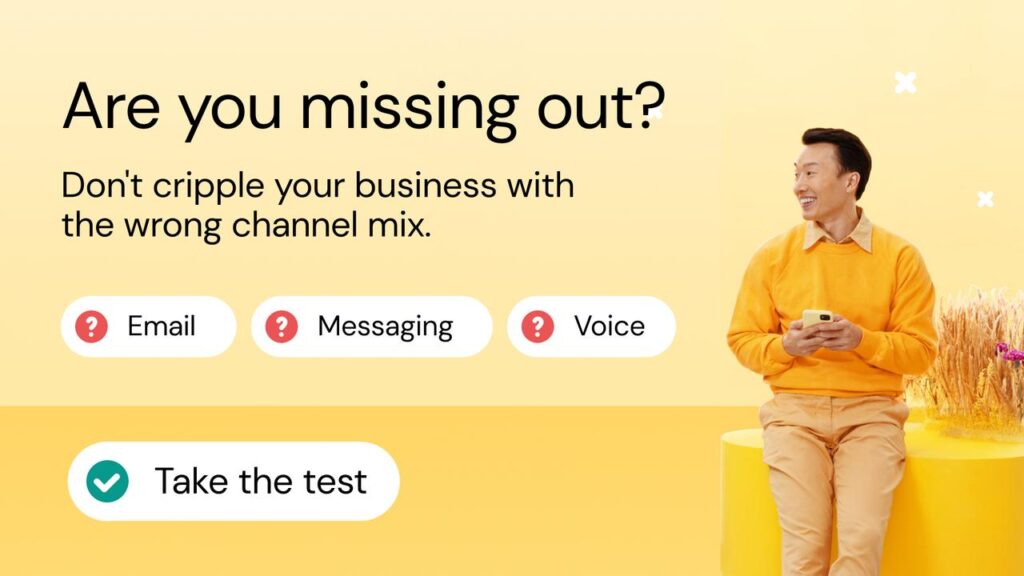Share article:
SMS and email: The power couple of customer communications

In the world of celebrities, power couples make a perfect pair despite their differences. Nicole Kidman and Keith Urban? Sure. David and Victoria Beckham? Why not. But what about SMS and email?
When it comes to your customer communication strategy, this duo might be the most powerful of all. A new report from Sinch, The art and heart of meaningful customer connections, has the numbers to prove it.
The research includes survey results from more than 500 consumers, revealing their preferences and expectations around the way brands communicate with them throughout the customer journey.
One thing the report makes crystal clear… SMS and email have won the hearts of most consumers. But why?
3 reasons why SMS and email are the top communication channels
Question after question, throughout the survey findings, email and SMS were the channels that came out on top as user favourites. But it’s not just consumers who see value in these forms of customer communication either, so do businesses.
Sinch also surveyed more than 400 B2C companies to ask about their communication strategies. Results show 92% of businesses use email to reach customers and 73% send customers text messages via SMS.

Businesses focus on these channels because they’re two efficient, effective, and reliable ways to reach a mass audience of consumers. At the same time, these businesses choose to communicate over SMS and email because that’s what their customers expect and prefer.
So, what is it about email and SMS that make them consumers’ favourites?
1. Familiarity
A big reason that SMS and email are consistently the top choices is because consumers are very comfortable with them. It’s what they’ve become familiar with because nearly everyone uses email and SMS.
Email has been around for decades, and it’s an important channel for brand communications. People are used to getting emails from brands, but it’s less common to use email for everyday, peer-to-peer (P2P) communication with family and friends.
Text messaging, however, is a primary way for people to communicate in their personal lives. At the same time, SMS communications from brands have become very common. That makes it an appropriate channel to create customer connections that feel more familiar and conversational.
When a consumer creates a new account, they often submit both their email address and mobile phone number at signup. While you should always obtain consent, new customers are likely expecting to hear from you via SMS and email.
It may not be the same for other mobile messaging channels. Some consumers may not yet be comfortable hearing from brands on Facebook Messenger, Instagram, or WhatsApp because they feel it should be reserved for P2P messaging. Still, we’re not saying you should exclude these channels from the mix. They represent excellent opportunities to connect when consumers give you permission.
2. Convenience
Throughout Sinch’s report, the research suggests what consumers want from brand communications is a more convenient experience. Your messages should make their lives easier. That could include anything from a personalised email promotion that helps them save on products they love to an SMS notification that a shipment has arrived.
Sinch found 54% of consumers cited factors impacting convenience as most important when they first connect with a B2C brand. Consumers want companies to be easy to work with, provide useful information, and answer their questions quickly.
Consumers’ familiarity with email and SMS also makes them a convenient way to communicate.
On the other hand, the fastest way to get on a consumer’s bad side is to become an inconvenience. The top two “dealbreakers” for consumers were related to getting too many messages (26%) or receiving irrelevant communications from a company (25%).
Consumer communication dealbreakers

Interestingly, only 8% of consumers chose problems with their order or account as a dealbreaker. That means they’re more willing to forgive mistakes than they are to be annoyed by excessive or irrelevant communications.
3. Timeliness
Speed or timeliness of message delivery is directly connected to convenience. This is an area where SMS communication truly shines. It may be the best way to reach customers and contacts quickly. Here’s why:
- SMS messages are delivered to consumers almost instantly.
- Most text messages are read within five minutes.
- SMS achieves open rates as high as 98%.
The need for speed is highlighted throughout Sinch’s Customer Connections report. For example, consumers expect certain types of messages will arrive quickly, and the speed of SMS helps you meet those expectations.
- After signing up, 80% of customers expect a message from a brand within 24 hours.
- 37% want to hear from the company immediately after signup.
- 62% of consumers expect receipts from online purchases to arrive within five minutes or less.
- 61% of consumers expect verification codes to get delivered in one minute or less.
Many survey respondents also indicated they’d worry if transactional communications like order confirmations or one-time passwords (OTPs) failed to show up quickly.
Email has a role in timely customer communications as well. Advanced features like Send Time Optimisation from Sinch Mailgun use machine learning to automatically find the best time to send emails to individual subscribers based on when they’re most likely to engage.
How SMS and email support the customer experience
Let’s dive deeper into the findings to explore specific situations where communication plays a vital role in the customer experience. How do email and SMS fit into these scenarios?
Whether it’s choosing the right channel for the situation or the preferred method of communication for the customer, the message is undeniable… Using both text messaging and email marketing helps you deliver what consumers want.
Promotional messages
Once an individual opts in to receive your promotions, is there a specific channel on which they’d prefer to receive marketing campaigns? The survey found email and SMS were the top choices for existing customers (those who’ve previously purchased).

39% of consumers want promotional campaigns delivered to their email inboxes while 21% would choose an SMS message to learn about the latest deals and updates.
While email has the advantage of sending longer messages with graphics, product images, and buttons for calls to action (CTAs), SMS is limited to short text messages and links. However, options like MMS (Multimedia Messaging Service) and RCS (Rich Communication Services) can make text marketing campaigns more versatile, visual, and even interactive.
Order confirmation messages
After a promotion prompts someone to purchase, which channel is best for receiving confirmation that an order successfully placed and is being processed? 37% of consumers would select email while 23% would prefer SMS for order confirmations.

Email has a slightly larger lead over SMS when we asked consumers about receiving the actual receipt or invoice for an online order. In that case, 42% would choose email while 20% chose SMS for receipts. This may be because it’s easier to search the email inbox and keep important invoices and receipts organised in folders.
Verification for account access
The gap between SMS and email narrows when it comes to verifying consumer identities when they’re logging in or need help accessing an account. A quick text message with a verification code or temporary password is a fast, reliable, and secure way to get logged in.
While a third of consumers want these communications delivered to their email address, more than a quarter of people prefer SMS. When combining all messaging channels, 45% of consumers prefer verifying their identity on a non-email channel.

Alerts about account activity
If a bad actor is trying to gain access to a consumer’s account, or there’s suspicious activity to report, time is of the essence. In this situation, 34% of consumers would choose email and 25% want to be notified with an SMS message.

A speedy text message is an ideal option when you need to alert consumers and get them to take immediate action. That’s why many financial services companies use texts to notify people of possible fraud.
What about MMS and other mobile messaging channels?
It’s worth noting that SMS and MMS aren’t necessarily separate channels. They’re simply different protocols delivered through the same channel – the text message inbox. The same goes for RCS and RBM (Rich Business Messaging), which represents the next phase of interactive text messaging experiences.
If you combine MMS results with SMS, Sinch’s survey shows text message marketing is even more popular than if you look at these protocols separately. Plus, the report shows that when you tally up all mobile messaging options, they come close to and even exceed consumer preferences for email.
What does this mean for your business? It’s wise to diversify your customer communication strategy and move towards an omnichannel approach.
Try it out for yourself
Start a 14-day free trial and see how text marketing can help grow your business

Email and SMS may not be going anywhere anytime soon. However, consumer behaviours constantly evolve. That’s especially true when it involves technology and digital media. Are you prepared for the future? What about the next generation of consumers?
A recent study on small business marketing from Sinch SimpleTexting found Gen Z consumers were less likely than older generations to prefer email. They had a slight preference for text compared to older consumers. However, they were much more likely to want to get marketing communications from brands via social media.
This suggests the ability to connect with consumers on social messaging apps like Messenger, Instagram, and WhatsApp will become important soon. Where you do business matters as well. For example, statistics show that nearly 45% of Australians are using WhatsApp (for what it’s worth – that beats Aussie TikTok usage). If you serve customers in Asia, over-the-top (OTT) channels like WhatsApp are extremely popular in certain regions. More than 90% of Indonesians and 83% of people in India use WhatsApp too.
The good news for your communication strategy
Here’s the thing… if you’re already using SMS and email to reach your target audience, you’ve picked the two most practical and powerful channels. Congrats! This means you’ve likely got your bases covered and can connect with your customers where they expect to hear from you.
That’s what makes email and SMS the power couple of customer communications. They may not be quite as famous as Beyoncé and Jay-Z, but they pack a serious punch.
Just remember, it’s not only about the channels you choose to use, but it’s how you use them to interact with your customer base. For example, Sinch MessageMedia integrates with tons of martech platforms. This enables you to use customer data to build relevant, personalised mobile messaging campaigns. Our platform also integrates with Sinch Mailgun helping you deliver cohesive customer communications with an SMS-to-email gateway. Sinch MessageMedia also provides a feature to turn emails into SMS messages. See how nicely these two play together?
If you’re thinking about moving beyond SMS and email to reach more people in more places, Sinch can help you develop the right strategy. Take a free assessment and receive a personalised report with recommendations for your business.


